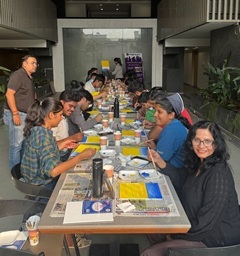Kathputli is a story of the people who bring it to life.


Kathputli is a traditional Indian puppetry art form that dates back to several centuries. It is a form of storytelling through puppets made of wood and cloth. The word “Kathputli” is derived from two Hindi words Kath (काठ) meaning “wood” and Putli (पुतली) meaning “doll.” This art form originated in Rajasthan and has since spread to other parts of India, including Delhi and Uttar Pradesh.
The story behind Kathputli is that a long time ago, a king ordered all the toys in his kingdom to be burned, including the beloved puppets of a group of wandering performers. In response, the performers created new puppets out of twigs and cloth and brought them to life with their imagination and music. The king was so impressed with the new puppets that he invited the performers to stay and put on a show for his court.
From then on, Kathputli became a beloved form of entertainment, passed down through generations of performers. It is said that the magic of the puppets lies in the way they are brought to life by the music and imagination of the performers, who use their art to tell tales of heroism, romance, and comedy.
The other folklore is around a magical puppet who is brought to life by a woodworker. The puppet becomes a famous performer and eventually falls in love with a human girl. Despite their love for each other, the puppet must eventually return to its wooden form and the couple must part ways.
Throughout the story, the puppet must navigate the challenges of the human world and deal with those who seek to use its magic for their own gain. In the end, the puppet decides to return to its wooden form, sacrificing its human life and its love for the girl in order to fulfill its purpose as a magical puppet. The story concludes with a powerful message about the importance of following one’s true nature and the sacrifices that must be made in the pursuit of love and self-discovery.
Kathputli is mentioned in ancient texts like Bhagavad Gita.
ईश्वर: सर्वभूतानां हृद्देशेऽर्जुन तिष्ठति |
भ्रामयन्सर्वभूतानि यन्त्रारूढानि मायया ||
The Supreme Being (God) is present in the hearts of all beings and directs their actions, as if they were puppets controlled by the puppet master.
The puppets used in Kathputli performances are carved out of light-weight wood and are often painted in bright colors. The bodies of the puppets are covered in brightly colored cloth and are dressed in traditional Indian attire. The puppeteers control the movements of the puppets using strings attached to their limbs and heads.
Kathputli performances typically include stories from Indian folklore, myths, and legends. The performances are usually accompanied by music, singing, and dialogues. The art form is performed by both men and women and is often passed down from generation to generation within families.
Despite its long history, the art of Kathputli is facing challenges today. The traditional art form is losing popularity, particularly among younger generations, due to the increasing availability of electronic forms of entertainment. Additionally, many of the skilled puppet makers and performers have passed away or have stopped practicing the art form, making it difficult to preserve.
Efforts are being made to revive and preserve the traditional art form of Kathputli. Several organizations are working to train and support the remaining puppeteers and to promote the art form to new audiences.
In conclusion, Kathputli is a unique and fascinating art form that has been an integral part of Indian culture for centuries. It is a form of storytelling that is not only entertaining but also rich in history and cultural significance. Efforts are underway to preserve this traditional art form and to ensure that future generations can continue to enjoy its beauty and charm.
Image credit: https://commons.wikimedia.org/wiki/File:Katputli.jpg under Creative Commons Attribution-Share Alike 4.0 International license

Create, Connect, Collaborate!
